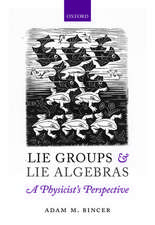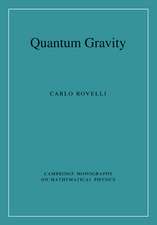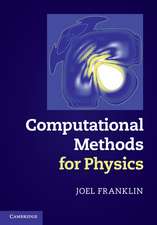Global Aspects of Classical Integrable Systems
Autor Richard H. Cushman, Larry M. Batesen Limba Engleză Hardback – 10 iun 2015
| Toate formatele și edițiile | Preț | Express |
|---|---|---|
| Paperback (1) | 397.38 lei 6-8 săpt. | |
| Birkhäuser Basel – 5 oct 2012 | 397.38 lei 6-8 săpt. | |
| Hardback (1) | 737.09 lei 6-8 săpt. | |
| Springer – 10 iun 2015 | 737.09 lei 6-8 săpt. |
Preț: 737.09 lei
Preț vechi: 898.88 lei
-18% Nou
Puncte Express: 1106
Preț estimativ în valută:
141.06€ • 146.37$ • 117.90£
141.06€ • 146.37$ • 117.90£
Carte tipărită la comandă
Livrare economică 17-31 martie
Preluare comenzi: 021 569.72.76
Specificații
ISBN-13: 9783034809177
ISBN-10: 3034809174
Pagini: 500
Ilustrații: XVIII, 477 p. 86 illus., 69 illus. in color.
Dimensiuni: 155 x 235 x 32 mm
Greutate: 0.87 kg
Ediția:2nd ed. 2015
Editura: Springer
Colecția Birkhäuser
Locul publicării:Basel, Switzerland
ISBN-10: 3034809174
Pagini: 500
Ilustrații: XVIII, 477 p. 86 illus., 69 illus. in color.
Dimensiuni: 155 x 235 x 32 mm
Greutate: 0.87 kg
Ediția:2nd ed. 2015
Editura: Springer
Colecția Birkhäuser
Locul publicării:Basel, Switzerland
Public țintă
ResearchCuprins
Foreword.- Introduction.- The mathematical pendulum.- Exercises.- Part I. Examples.- I. The harmonic oscillator.- 1. Hamilton’s equations and S1 symmetry.- 2. S1 energy momentum mapping.- 3. U(2) momentum mapping.- 4. The Hopf fibration.- 5. Invariant theory and reduction.- 6. Exercises.- II. Geodesics on S3.- 1. The geodesic and Delaunay vector fields.- 2.The SO(4) momentum mapping.- 3. The Kepler problem.- 3.1 The Kepler vector field.- 3.2 The so(4) momentum map.- 3.3 Kepler’s equation.- 4 Regularization of the Kepler vector field.- 4.1 Moser’s regularization.- 4.1 Ligon-Schaaf regularization.- 5. Exercises.- III. The Euler top.-1. Facts about SO(3).- 1.1 The standard model.-1.2 The exponential map.- 1.3 The solid ball model.- 1.4 The sphere bundle model.- 2. Left invariant geodesics.- 2.1 Euler-Arnol’d equations on SO(3) ⇥ R3.- 2.2 Euler-Arnol’d equations on T1 S2 ⇥ R3.- 3. Symmetry and reduction.- 3.1 SO(3) symmetry.- 3.2 Construction of the reduced phase space.- 3.3 Geometry of the reduction map.- 3.4 Euler’s equations.- 4. Qualitative behavior of the reduced system.- 5. Analysis of the energy momentum map.- 6. Integration of the Euler-Arnol’d equations.- 7. The rotation number.- 7.1 An analytic formula.- 7.2 Poinsot’s construction.-8. A twisting phenomenon.- 9. Exercises.- IV. The spherical pendulum.- 1. Liouville integrability.- 2. Reduction of the S1 symmetry.-2.1 The orbit space T S2 /S1.- 2.2 The singular reduced space.- 2.3 Differential structure on Pj ).- 2.4 Poisson brackets on C• (Pj ).- 2.5 Dynamics on the reduced space Pj.- 3. The energy momentum mapping.- 3.1 Critical points of EM.- 3.2 Critical values of EM.- 3.3 Level sets of the reduced Hamiltonian H j |Pj.- 3.4 Level sets of the energy momentum mapping EM.- 4. First return time and rotation number.- 4.1 Definition of first return time and rotation number.-4.2 Analytic properties of the rotation number.-4.3 Analytic properties of first return time.-5. Monodromy.- 5.1 Definition of monodromy.- 5.2 Monodromy of the bundle of period lattices.-6. Exercises.- V. The Lagrange top.-1.The basic model.- 2. Liouville integrability.- 3. Reduction of the right S1 action.- 3.1 Reduction to the Euler-Poisson equations.-3.2 The magnetic spherical pendulum.- 4. Reduction of the left S1 action.-4.1 Induced action on P a.- 4.2 The orbit space (J a ) 1 (b)/S1.- 4.3 Some differential spaces.- 4.4 Poisson structure on C•(P a ).- 5. The Euler-Poisson equations.- 5.1 The twice reduced system.- 5.2 The energy momentum mapping.- 5.3 Motion of the tip of the figure axis.-6. The energy momentum mapping.- 6.1 Topology of EM 1 (h, a, b) and H 1 (h).- 6.2 The discriminant locus.- 6.3 The period lattice.- 6.4 Monodromy.- 7. The Hamiltonian Hopf bifurcation.- 7.1 The linear case.- 7.2 The nonlinear case.- 8. Exercises.- Part II. Theory.-VI. Fundamental concepts.-1. Symplectic linear algebra.- 2. Symplectic manifolds.- 3. Hamilton’s equations.- 4. Poisson algebras and manifolds.- 5. Exercises.- VII. Systems with symmetry.-1. Smooth group actions.- 2. Orbit spaces.- 2.1 Orbit space of a proper action.-2.2 Orbit space of a proper free action.- 3. Differential spaces.- 3.1 Differential structure.- 3.2 An orbit space as a differential space.- 3.3 Subcartesian spaces.- 3.4 Stratification of an orbit space by orbit types.- 3.5 Minimality of S.- 4. Vector fields on a differential space.- 4.1 Definition of a vector field.- 4.2 Vector field on a stratified differential space.- 4.3 Vector fields on an orbit space.- 5. Momentum mappings.-5.1 General properties.- 5.2 Normal form.- 6. Regular reduction.- 6.1 The standard approach.- 6.2 An alternative approach.- 7. Singular reduction.- 7.1 Singular reduced space and dynamics.- 7.2 Stratification of the singular reduced space.- 8. Exercises.- VIII. Ehresmann connections.-1. Basic properties.- 2. The Ehresmann theorems.- 3. Exercises.- IX. Action angle coordinates.- 1. Liouville integrable systems.- 2. Local action angle coordinates.- 3. Exercises.- X.Monodromy.-1. The period lattice bundle.-2. The geometric mondromy theorem.- 2.1 The singular fiber.- 2.2 Nearby singular fibers.- 2.3 Monodromy.- 3. The hyperbolic billiard.- 3.1 The basic model.- 3.2 Reduction of the S1 symmetry.- 3.3 Partial reconstruction.- 3.4 Full reconstruction.- 3.5 The first return time and rotation angle.-3.6 The action functions.- 4. Exercises.- XI. Morse theory.-1. Preliminaries.- 2. The Morse lemma.- 3. The Morse isotopy lemma.- 4. Exercises.- Notes.-Forward and Introduction.- Harmonic oscillator.- Geodesics on S3.- Euler top.- Spherical pendulum.- Lagrange top.- Fundamental concepts.- Systems with symmetry.- Ehresmann connections.- Action angle coordinates.- Monodromy.- Morse theory.-References.- Acknowledgments.-Index.
Textul de pe ultima copertă
This book gives a uniquely complete description of the geometry of the energy momentum mapping of five classical integrable systems: the 2-dimensional harmonic oscillator, the geodesic flow on the 3-sphere, the Euler top, the spherical pendulum and the Lagrange top. It presents for the first time in book form a general theory of symmetry reduction which allows one to reduce the symmetries in the spherical pendulum and the Lagrange top. Also the monodromy obstruction to the existence of global action angle coordinates is calculated for the spherical pendulum and the Lagrange top. The book addresses professional mathematicians and graduate students and can be used as a textbook on advanced classical mechanics or global analysis.
Caracteristici
This book gives a complete global geometric description of the motion of the two dimensional harmonic oscillator, the Kepler problem, the Euler top, the spherical pendulum and the Lagrange top
This book is necessary because the standard treatments are not complete
Main goal of this book is to understand the global geometric features of our model integrable systems
Includes supplementary material: sn.pub/extras
This book is necessary because the standard treatments are not complete
Main goal of this book is to understand the global geometric features of our model integrable systems
Includes supplementary material: sn.pub/extras
Recenzii
"Ideal for someone who needs a thorough global understanding of one of these systems [and] who would like to learn some of the tools and language of modern geometric mechanics. The exercises at the end of each chapter are excellent. The book could serve as a good supplementary text for a graduate course in geometric mechanics."
--SIAM Review
--SIAM Review






















